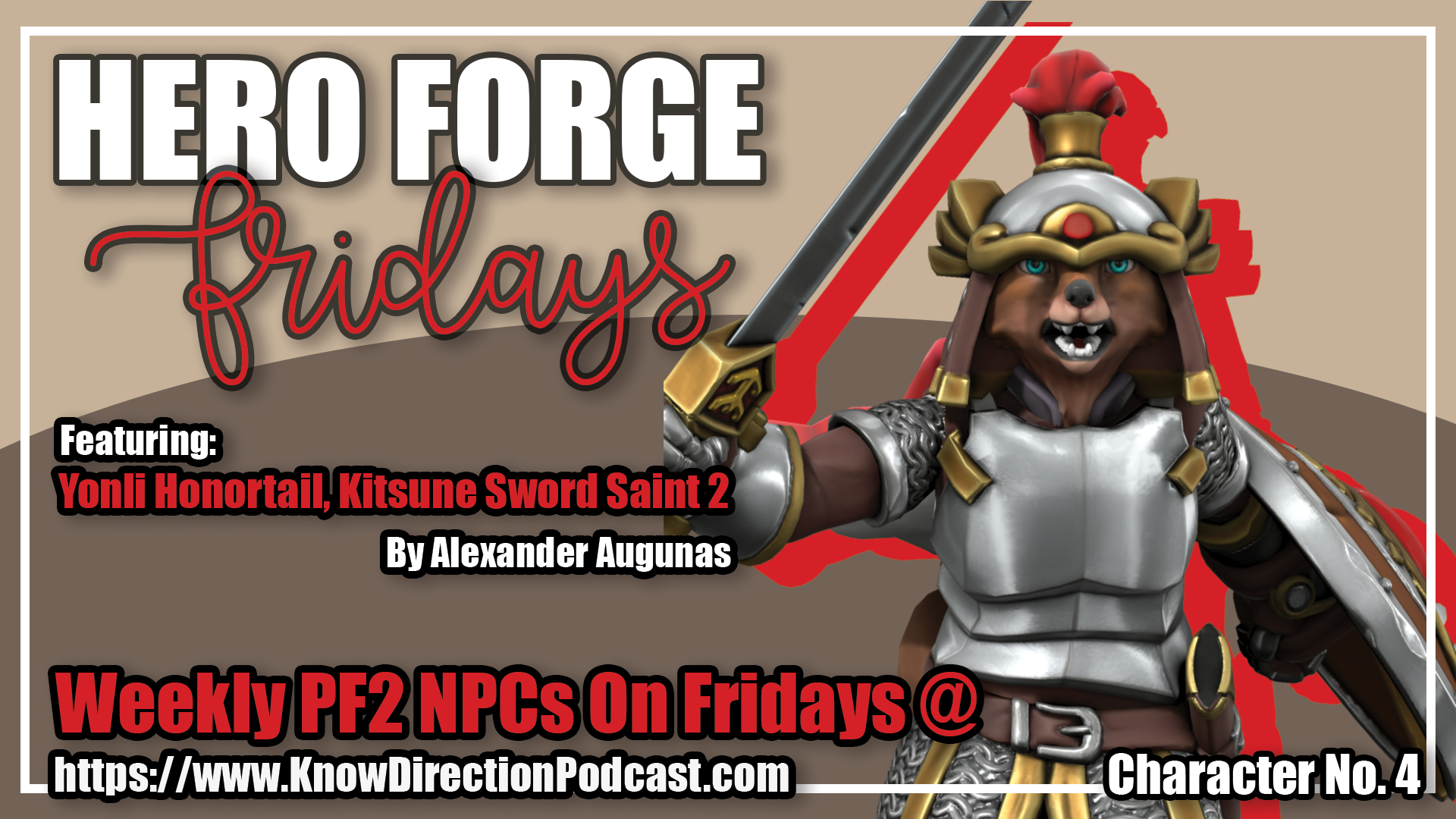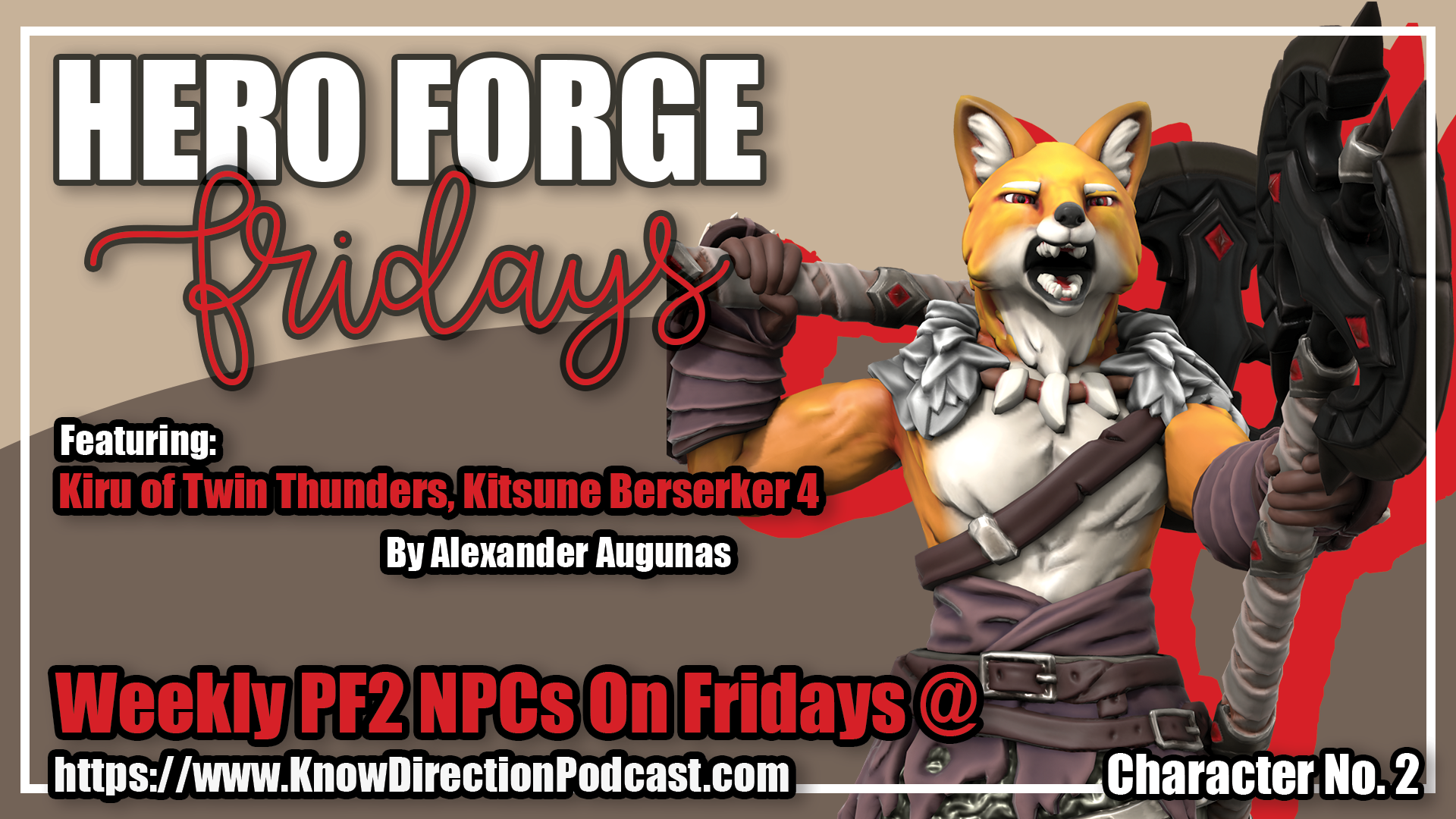Welcome to Guidance, Private Sanctuary’s source for tips and techniques for the Pathfinder Roleplaying Game, written by Everyman Gamer Alexander Augunas. Today, we’re going to be looking at a Swiper the Fox build.
If you’ve been following Anthony and me at our Facebook group, 3.5 Private Sanctuary, you’ll likely know that I made a brazen statement last month. In April, I proclaimed that if the Pathfinder Society made the Unchained Rogue PFS legal, I would make (and play) a Swiper the Fox build using the Unchained Rogue.
Who’s Swiper the Fox? A perfect match for our Barney the Nagaji build, that’s for sure! Sit back, relax, and enjoy the ridiculousness that is my Swiper the Fox Build.
Background
From the Dora the Explorer Wiki:
Swiper is the main antagonist of [Dora the Explorer] and appears in nearly every single episode. He is a sneaky orange fox. As his name implies, Swiper steals or attempts to steal key items that help Dora on her adventures. Clever as he is, Swiper never manages to take Dora completely by surprise; an ominous “whisking” sound is always audible just prior to his appearances.
To prevent Swiper from success, Dora must repeat the phrase, “Swiper, no swiping!” three times. Usually she prevails, and Swiper slinks away, snapping his fingers and saying, “Oh, man!”; sometimes, however, Swiper gets to the item before Dora has a chance to repeat the phrase. He then gloats, “You’re too late!” (and frequently “You’ll never find it now! Ha, ha, ha, ha!!”).
Swiper’s motive for theft is patently childish; he never seems actually to want the object he takes, since he almost immediately throws it away to hide the item from Dora (prompting her to ask the audience to help her find it). Until recently, it was unclear if he swipes merely for the joy of swiping, or from a desire to annoy and frustrate Dora. Compounding the confusion is the fact that, given the right reason, for example, that the item in question is a present for Dora’s puppy, he’ll return items he has taken, no matter how much effort he went through to get them. It is also shown that he rarely knows the full importance of what he’s taken; for example, he had no idea the aforementioned gift was for Dora’s puppy. In the episode “Dora Saves the Mermaids”, he revealed that he “liked swiping.” He has some kind of New York accent, and lives in a burrow on top of Blueberry Hill.
Swiper is very fast and agile, and something of a master of disguise. He seems to have a great deal of technical knowledge, as he’s built a variety of vehicles and gadgets (including a remote-controlled robot butterfly) to help him swipe things. Most of the time, however, he simply relies on his natural stalking abilities (sometimes with the aid of a costume) to sneak up on Dora. In the early episodes he often “hid” by curling up into a ball, which neither Dora nor Boots ever recognized as Swiper; he apparently doesn’t do this anymore.
Build Concept
I was never a Dora the Explorer fan, but the possibilities for this character are making me grin from ear to ear (especially considering that I’m going to play him as a member of the Exchange). Let’s look at how I’m going to pull off this wacky concept.
- Rogue, Unchained: I REALLY wanted to take a thieving-based archetype for this build, but the absolute best steal-themed archetype is hafling-only, which really won’t do. Ultimately, I’m going to stick with the unmodified unchained rogue class for this build.
- Steal/Disarm Specialization: I’m going to be building Swiper to get the most advantage possible out of the steal and disarm combat maneuvers. These aren’t often the best maneuvers on the block simply because not everything you fight is going to have things to disarm or steal, but it fits the character and against many opponents, a good disarm can really shut them down.
Alright, with all that out of the way, let’s check out the build!
Early Levels (1–7)
- Classes: unchained rogue 7
- Favored Class – Rogue: major magic: vanish
- Feats: Weapon Finesse (Bonus), Two-Weapon Fighting (1st), Combat Expertise (Bonus), Improved Disarm (3rd), Break Guard (5th), Improved Steal (Bonus) Agile Maneuvers (7th)
- Abilities: danger sense +4, debilitating injury, evasion, finesse training (shortsword, gauntlet), improved uncanny dodge, rogue’s edge (Sleight of Hand), rogue talents (combat swipe, combat trick, minor magic: prestidigitation), sneak attack +7d6, trapfinding, uncanny dodge
- Trait: Heirloom Weapon (gladius; proficiency)
Okay, so the first thing that I decided on quickly was that I was going to focus on Two-Weapon Fighting. Why? There’s this AWESOME feat called Break Guard from Ultimate Combat that I want. How Break Guard works is that whenever I successfully disarm my target, I can spend a swift action in order to immediately attack with my other weapon. In effect, Break Guard lets you “regain” one attack that you used to make a disarm attempt one per round. Its an extremely helpful ability, especially when it comes to maintaining damage on the target. Now, as for the weapons I’m using to Two-Weapon Fighting with the gladius and the gauntlet. I’m picking this combination for a specific reason: One, between the two of them I have an attack that overcome all types of damage type-related DR (gladius is piercing or slashing, gauntlet is bludgeoning). Two, I want a weapon in my off-hand that isn’t going to interfere with my ability to steal stuff. When you successfully disarm an opponent with an unarmed strike, you can grab that weapon as a free action. And lucky for me, gauntlets count as unarmed strikes (not for monk damage boosts, but you can flurry with them and such as well). Early on, this is why I don’t take any feats that improve Two-Weapon Fighting (that and I can’t afford them with all the other feats I need). I don’t want to make a second gauntlet attack because whenever I disarm someone, I’m going to take (and keep) that weapon. That is, until the mid levels where I can throw that weapon all over the place in true Swiper fashion.
There are a couple (two) feat taxes that I basically have to pay for this build. Even though the combat swipe rogue talent allows me to ignore Combat Expertise for the Improved Steal feats, I still need it for the Improved Disarm feats, so I have to take it. Furthermore, as far as I know you can’t use Weapon Finesse to get Dex to CMB with steal maneuvers because steal attempts don’t replace melee attacks, so I need to grab Agile Maneuvers if I’m going to be halfway decent at using the steal maneuver.
The nice thing about gladiuses is that they count as shortswords for all effects, so I can pick finesse training: shortsword (which allows me to use my Dex to damage with the selected weapons at 3rd level) and have it apply to my gladius. Honestly, I see no reason to ever take any feat or ability with the gladius when it will simply piggyback off of shortsword options. Not that I take many weapon-specific abilities in this build: most of my feats are spent building up to Break Guard while most of my talents are focused on awesome tricks to help me out. Combat trick and combat swipe help me qualify for the feats that I need to make my build function while minor magic and major magic (the latter of which I took with my kitsune favored class bonus) got buffed substantially for the unchained rogue: in effect, minor magic gives you your chosen cantrip at while while magic magic gives you one use per two rogue levels of one major rogue talent of your choice. There are a few excellent options, but I’m choosing vanish. Being able to turn invisible for up to 6 rounds three times per day at 6th level is fantastic; it’s not unlike the vanishing step ninja trick, really.
My skill unlock for this tier is going to be Sleight of Hand; it has this nifty bonus at 5 ranks that allows me to attempt a Sleight of Hand skill check whenever I attempt to disarm or steal something to get a small bonus on my combat maneuver check. Helpful, especially since I need to invest into Sleight of Hand anyway for the mid-levels. Finally, there’s debilitating injury. This awesome class feature allows me to inflict some major penalties on my opponents if I manage to successfully sneak attack them. Normally, this might be tricky, but with the ability to cast vanish as a spell-like ability, I can sneak up on an opponent and be guaranteed at least one sneak attack, regardless of where I’m positioned.
Who’d have thought that I’d need to do so much explaining for the early levels of a ROGUE build? Let’s move on to the mid-levels and see how this build improves.
Mid Levels (8 –14)
- Classes: unchained rogue 14
- Favored Class – Rogue: major magic: vanish, skill mastery
- Feats: Weapon Finesse (Bonus), Two-Weapon Fighting (1st), Combat Expertise (Bonus), Improved Disarm (3rd), Break Guard (5th), Improved Steal (Bonus) Agile Maneuvers (7th), Greater Disarm (9th), Directed Disarm (11th), Greater Steal (13th), Combat Reflexes (Bonus)
- Abilities: advanced talents (feat: Combat Reflexes, improved evasion, weapon snatcher), danger sense +4, debilitating injury, evasion, finesse training (shortsword, gauntlet), rogue’s edge (Acrobatics, Sleight of Hand), rogue talents (combat swipe, combat trick, minor magic: prestidigitation, trap spotter), sneak attack +7d6, trapfinding, uncanny dodge
These levels are the absolute best for this build. So the first thing you’ll likely notice is that for my PFS character, I’m not going to be grabbing Greater Steal for a LONG time, which is sort of strange considering that my build is a character named SWIPER the fox. In truth, I think the extra +2 on Steal maneuvers is redundant and the special perk for the feat (enemies don’t realize you’ve stolen anything from them) doesn’t really fit my character very well. Instead, I picked up Greater Disarm (which allows me to toss weapons up to 10 feet away after I disarm them) and Directed Disarm (which increases the toss distance to 15 feat AND allows me to attack folks with the disarmed weapon). One thing that Directed Disarm notes is that I take a –4 penalty on the attack roll with the disarmed weapon if it isn’t a thrown weapon; although the feat never states that this is due to nonproficiency, I think its pretty much certain that nonproficiency is the reason that you take this penalty. I’m wondering if I could take Throw Anything and ignore that penalty, but since the rules text doesn’t make that clear or not (even though I’m probably right intent-wise) I’m not going to bother with Throw Anything.
For my second rogue’s edge, I picked Acrobatics. Acrobatics is definitely a skill that I’ll need to successfully move around the battlefield, and the unlocks for Acrobatics are pretty awesome. For talents, I chose trap spotter as my 8th-level talent, weapon snatcher for my 10th, improved evasion for my 12th, with skill mastery as my racial favored class bonus skill, and feat: Combat Reflexes as my 14th-level talent. Trap spotter is all around useful as a time saver, in my opinion, while weapon snatcher is simply awesome; it lets you make a Sleight of Hand check instead of a CMB check for disarm combat maneuvers. Without much investment, I’m already going to be better off with a CMB check because I’m going to be keeping Sleight of Hand topped-off rank-wise. Using magic items, feats, and other abilities, I can pump Sleight of Hand much more easily than my CMB, making this a must-have rogue talents. In my opinion, the others I picked are pretty standard.
So, its unlikely I’ll get to the End Game with Swiper, but let’s see what that could look like regardless.
Endgame (15+)
- Classes: unchained rogue 20
- Favored Class – Rogue: major magic: vanish, skill mastery, ledge walker
- Feats: Weapon Finesse (Bonus), Two-Weapon Fighting (1st), Combat Expertise (Bonus), Improved Disarm (3rd), Break Guard (5th), Improved Steal (Bonus) Agile Maneuvers (7th), Greater Disarm (9th), Directed Disarm (11th), Greater Steal (13th), Combat Reflexes (Bonus), Improved Two-Weapon Fighting (15th), Two-Weapon Defense (17th), Greater Two-Weapon Fighting (19th)
- Abilities: advanced talents (dispelling attack, feat: Combat Reflexes, improved evasion, light walker, opportunist, slippery mind, weapon snatcher), danger sense +6, debilitating injury, evasion, finesse training (shortsword, gauntlet, ANY ONE), master strike, rogue’s edge (Acrobatics, Sleight of Hand, ANY TWO), rogue talents (combat swipe, combat trick, minor magic: prestidigitation, trap spotter), sneak attack +10d6, trapfinding, uncanny dodge
Pretty tame end game, rounding off with some extra attacks and defenses via the Two-Weapon Fighting feat chain. I love the imagery that the character is able to use the protective gauntlet as a shield, which is the main reason I splurged for Two-Weapon Defense. Realistically, I could have also gone for Improved Feint instead, although the fact that Improved Feint isn’t available as a rogue talent is something that perplexes me to this day. I also grabbed dispelling attack (awesome), light walker and ledge walker (light walker is awesome, ledge walker is alright), and opportunist (FANTASTIC) as my final rogue talents. I’m not sure what I’d want to take with my last finesse training or my last two rogue edges, so I’m leaving them blank for now; it likely depends on what skills I end up using often in-game, but I’m willing to bet that Escape Artist would be one of them; that seems like a skill that I would invest in, as well as Stealth and Perception.
But with that, I’ve finished my Unchained rogue build! Now, I suppose we’ll see to what extent I stick with this plan when I actually start to play this character in Pathfinder Society, because speculative design and actual gameplay experiences are QUITE different, and one can only go so far based on speculation alone. For instance, without the ability to take magic items and stored items away from an opponent, I’m questioning how useful the steal maneuver is going to be. But in any case, we’ll see what happens when I start to play this character! Do you have any questions or comments about my build? Leave them in the comments below, and I’ll see you back here next week for more succulent content from the Know Direction suite! Take care!
Alexander “Alex” Augunas has been playing roleplaying games since 2007, which isn’t nearly as long as 90% of his colleagues. Alexander is an active freelancer for the Pathfinder Roleplaying Game and is best known as the author of the Pact Magic Unbound series by Radiance House. Alex is the owner of Everyman Gaming, LLC and is often stylized as the Everyman Gamer in honor of Guidance’s original home. Alex’s favorite color is blue and his favorite Pathfinder Race/Class combination is kitsune thief.






Leave a Reply